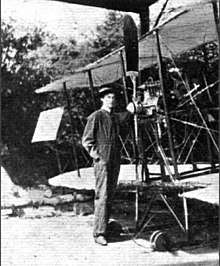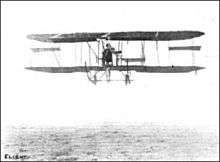Lilian Bland

Lilian Bland (28 September 1878[1] – 11 May 1971) was an Anglo-Irish journalist and aviator who, in 1910–11, became one of the first women in the world to design, build, and fly an aircraft - the Bland Mayfly.
Early life
Bland was born in Maidstone, Kent on 22 September 1878,[2] to a family of Anglo-Irish gentry, the third child of John Humphrey Bland and his wife Emily Charlotte (née Madden) and lived at Willington House, Willington Street (formerly, Willington Lane). Around the turn of the century, she began working as a journalist and press photographer for various London newspapers;[3] she lived an unconventional lifestyle for the period, smoking, wearing trousers, and practising martial arts.[4]
Between 1900 and 1906, following the death of her mother, Bland and her father moved to Tobercorran House in Carnmoney, north of Belfast, to live with her aunt Sarah.[4] Sarah Bland had married General William James Smythe, who had died in 1887 leaving no children, and the two siblings had decided to set up house together. From here, Bland continued her photographic work, spending days on remote Scottish islands photographing seabirds.[3]
Aviation career

Bland's uncle Robert sent her a postcard of the Blériot monoplane from Paris, inspiring her to take up flying. She studied the measurements of the monoplane, and added her own thoughts into the design of her plane, the Mayfly. The Mayfly had similar wings to Blériot's design, but it could get off the ground by itself. At that point, no one in Ireland had yet made a powered flight – the first would be Harry Ferguson, in December – and to make an aircraft would involve building it herself. Her late uncle, General William James Smythe, an astronomer and member of the Royal Society, had provided the house with a workshop, and after some background reading on the Wright brothers, Bland successfully built a flyable model biplane.[3]

From this, she progressed to a full-scale glider with others' help, which was built from spruce, bamboo and canvas, and completed early in 1910. For months of experiments, she made numerous glider flights to improve the plane. The resulting Mayfly was tested by gliding it from Carnmoney Hill, being progressively strengthened and tested with heavier loads, until Bland felt it was strong enough to take an engine. The load test was done by four Irish policemen. Since the plane could lift four policemen, Bland believed it could carry one English engine. She ordered a light 20 horsepower two-stroke engine from A. V. Roe & Co., and after some delays brought it to Carnmoney in July.[3]
The horizontally opposed two-cylinder engine achieved 20 horsepower at 1000 rpm. Bland was eager to test the engine-powered aircraft before its petrol tank was ready, so she improvised: an empty whisky bottle was used instead, with Bland's deaf aunt's ear trumpet as the engine hose. This construction was not quite a success—the engine's vibrations compromised the security of the plane's nuts, bolts, and struts, and Bland's flight would have to wait.[3]
Preparations of the Mayfly started in 1909 and continued in 1910. After miserable weather, the first successful flight was made at Randalstown in late August, a short hop off the ground. While perching on a canvas open-air seat, she manipulated controls to make the plane fly after running forward about 30 feet. The controls consisted of a bicycle handle bar. Not only did this make Bland the first woman to fly an aircraft in Ireland, but the Mayfly also became the first powered biplane in Ireland.[5] She continued experimenting with further flights, mostly around thirty feet (ten metres) in length, sometimes requiring examination of the ground to identify when the Mayfly had actually lifted off. The longest flight after the first try was approximately one quarter of a mile (400 metres). She began to plan an improved version, and offered examples for sale at £250 apiece plus engine to fund further development.[6] The Mayfly was able to stably glide over 90 yards and rise 30 feet even in gusty winds, according to Bland's words. The aircraft was however not capable of much more, and would not cope with a larger engine.[7] Finally, Bland gave the Mayfly airframe to a boy's gliding club and sold the engine. After that, she moved to northern Vancouver Island with her husband.
Later life
Bland's flying had been a source of some concern to her father, who saw it as unsafe as well as unseemly for a young woman. Around the end of the year, he persuaded her to give up the Mayfly in exchange for buying her a car. By April 1911 she was running a car dealership in Belfast, but in October gave up the business to marry her cousin Charles Loftus Bland, and emigrate to Canada.[6]
Bland returned to the United Kingdom in 1935, settling in Kent, and in the 1950s retired to Cornwall.[8] She died there, aged 92, on 11 May 1971.[7] She is commemorated by an Ulster History Circle blue plaque at the family home at Carnmoney.
References
Notes
- ↑ "Articles - Lilian Bland". womensmuseumofireland.ie. Women's Museum of Ireland. Retrieved 2018-09-28.
- ↑ Newmann 2012.
- 1 2 3 4 5 Lewis 1964, p. 140.
- 1 2 McIlwaine 2010.
- ↑ Bland 1910, p. 1025.
- 1 2 Andrews 2010.
- 1 2 Lewis 1964, p. 141.
- ↑ BBC 2010.
Sources
- Andrews, Helen (2010). "From the files of the DIB: Bland, Lilian Emily". History Ireland. 18 (1).
- Lewis, Peter (23 January 1964). "Lilian Bland and the Mayfly". Flight: 140–141. Retrieved 5 October 2012.
- McIlwaine, Eddie (2010). "Journalist, photographer, crackshot and the first woman to fly an aeroplane... the amazing Lilian Bland". Belfast Telegraph. Retrieved 5 October 2012.
- Bland, Lilian (1910). "The Mayfly: the first Irish biplane and how she was built". Flight (17 December 1910): 1025–1029. Retrieved 9 December 2013.
- Newmann, Kate (2012). "Lilian Bland (1878–1971)". Dictionary of Ulster Biography. Ulster History Circle. Retrieved 5 October 2012.
- BBC (31 August 2010). "Lilian Bland remembered". BBC Cornwall.
Further reading
- Bracken, Damian; Riain-Raedel, Dagmar Ó (2006). Ireland and Europe in the Twelfth Century: Reform and Renewal. Dublin: Four Courts Press. ISBN 978-1-85182-848-7.
- Lebow, Eileen (2002), Before Amelia: Women Pilots in the Early Days of Aviation, Potomac Books, ISBN 9781574884821
- Lewis, P. (1962). British Aircraft 1809-1914, pp 126-7. Putnam, London.
- Russell, Mary (2012), The Blessings of a Good Thick Skirt, HarperCollins, ISBN 9780007464142
- Warner, Guy (2010), Lilian Bland, Nicholson and Bass, ISBN 9781905989515